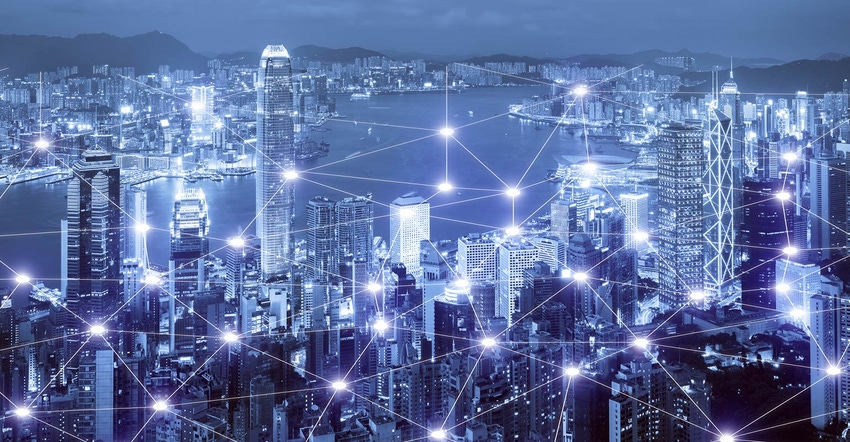Coming to an IoT deployment near you: blockchain, fewer generic IoT platform options and a growing role for data governance, according to an exec’s IoT predictions.
December 5, 2017

Last year, Don DeLoach sat down to predict what trends would characterize the Internet of Things in 2017. A board member of Centri, an advisory board member of Microshare and the co-chair of the Midwest IoT Council, DeLoach foresaw that machine-learning-driven IoT deployments would gain market momentum in general and in healthcare in particular. He foresaw an expanding role from drones for non-consumer applications such as forest management, construction and engineering. In addition, DeLoach, who is also the co-author of “The Future of IoT: Leveraging the Shift to a Data Centric World,” predicted an increase in policy in the United States, as well as an uptick in M&A activity in the general IoT market.
It turns out those broad trends were accurate. There has been a steady uptick in interest in technologies such as machine learning and artificial intelligence in 2017, as well as a growing number of use cases for related concepts such as predictive maintenance and detecting anomalous IoT network traffic. Machine learning is also making inroads in healthcare, as evidenced in last month’s interview with the CEO of GE Healthcare Digital. Drones are finding expanded use for enterprise and industrial applications, while also occasionally causing security-related headaches. As a recent example, The New York Times recently reported that U.S. officials suspect DJI of using commercial drones to send data to China. There has also been a push for greater IoT policy — most notably the Internet of Things Cybersecurity Improvement Act of 2017. On the M&A front, Intel, GE and Nokia made significant IoT acquisitions in 2017 by picking up Mobileye, ServiceMax and Comptel, respectively.

As this year draws to a close, DeLoach has come up with a new batch of IoT predictions pertaining to the role of blockchain in IoT initiatives, the fate of generic IoT platforms, thorny data ownership questions and more. Here, we share his predictions for 2018.
Blockchain and blockchain variants, along with cryptocurrencies will quickly become a key consideration. Even a casual view of the market right now reveals a number of IoT blockchain (or pseudo-blockchain) initiatives. The deployment of blockchain in an IoT context has largely been held back to date by concerns of security, performance and scale. Some of the performance issues are being addressed with variations to the “traditional blockchain,” and while it is still early days, there are signs everywhere this will become a reality. Security is probably the more significant issue. As we consider the ability to validate a transaction with certainty based on consensus, the market is still struggling with the need to ensure the identity of the parties in a transaction, as well as additional safeguards against other security issues. The idea that IoT security concerns are a thing of the past is ridiculous. It remains a sizable problem, and blockchain and related consensus technologies will solve pieces of this, but the puzzle remains unfinished.
General Purpose platforms will start to fall off, with a smaller number gaining stature and market share as the market begins to consolidate, with an associated increase in M&A. The market won’t sustain 700 horizontal IoT platforms, any more than it would support 700 general purpose search engines. And while the nuances of vertical markets within IoT may favor some platforms over others, that will account for perhaps 10 to 12 “winners” vs. Google and a few other search engines, but there won’t be 700 or even 70. As these different initiatives, propped up by early relationships and initial traction, give way to the platforms with the functional scope, performance and scale capabilities, analytic capabilities, and marketing and distribution firepower, we will surely see a number of these early platforms absorbed into the evolving ecosystem.
Awareness, specific education (especially at executive levels), and increased emphasis on organizations structure and process relative to IoT will increase.
Organizations will begin to understand IoT is no longer just the shiny penny that tracks steps or lets you know when energy consumption should be adjusted. They will see it has become table stakes for gaining the insight and taking the action needed for business to prosper. The profound gap in human capital, highlighted most notably by the weakness in executive’s understanding of IoT in their businesses, will begin to fade on a broad scale. We will see more in-house corporate education initiatives, more executive retreats for learning IoT, and more consulting firms with IoT-related awareness offerings.
[IoT World demonstrates how the next generation of IoT will converge to unlock the intelligence of things in the industrial, enterprise and consumer realms. Get your ticket now.]
Data ownership will continue to be a battle, but the volume of the dialog will rise as their stakes become more apparent.
The role of data governance will continue to become increasingly important. This trend is already apparent. As organizations bring in more and more IoT enabled devices, they will begin to demand ownership and control of the IoT data coming from those devices. This fact should not be at the expense of the IoT product provider. In fact, it is in the organization’s best interests to have the product provider continue to get that data. They just don’t have to get the data at the expense of the enterprise using the IoT-enabled device. They can contextualize the data alongside the myriad of other IoT devices they use, and ultimately cleanse and enrich that data with other enterprise systems data such as ERP and POS, etc. They can also interweave it with available third-party data. They can do all of this with the goal of creating a richer, context-aware signature that allows them to gain better insight and make better decisions.
Privacy will become a key part of the conversation. This topic will become the elephant in the room. The approach to data exploitation has long been widespread, and distrust amongst the public has been growing. For more on this point, check out the section on privacy in this piece titled “8 IoT security trends to look out for in 2018.”
Analytics (and data leverage) will continue to be the thing. This trend will manifest itself mostly in the form of digital twins, but this has been trending this way for some time, so adding it as an IoT prediction here is just not to omit what everyone already knows. No more dialog required.
About the Author(s)
You May Also Like



.png?width=300&auto=webp&quality=80&disable=upscale)


.png?width=300&auto=webp&quality=80&disable=upscale)